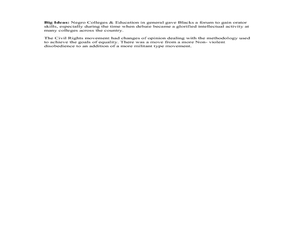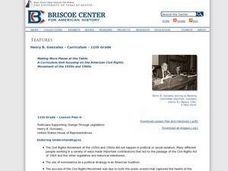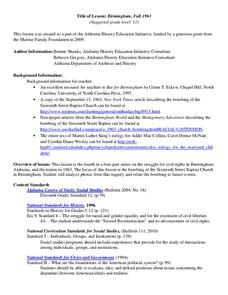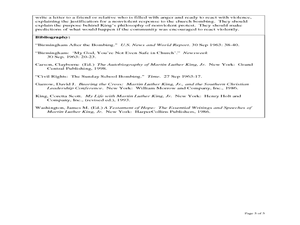Curated OER
Nonviolence as a Tool for Change Lesson 1
Young scholars examine voting rights in the South during the 1950s and 1960s. In this civil rights lesson, students examine legal rights and the opportunity to cast votes. Young scholars research primary documents regarding the topic and...
Curated OER
The March from Selma to Montgomery
Students examine voter discrimination. In this Civil Rights lesson, students watch segments of "Eyes on the Prize" and discuss the organization of the march from Selma to Montgomery. Students conduct interviews to learn personal stories...
Curated OER
Bill of Rights Day (December 15th)
On December 15, 1791, the ratification of the first ten amendments to the Constitution of the UnitedStates of American by three-quarters of the states took place. These were subsequently incorporated into the Constitution and became...
Curated OER
The Sixties Protests and Social Change
Students identify, examine and analyze photographs of the sixties to determine the forces of social change at work in America during this decade. They determine the goals of each movement and the methods used by each to achieve those goals.
Curated OER
The Bill of Rights
Ninth graders examine various Supreme Court Cases. In this American Government lesson, 9th graders research a specific Supreme Court Case. Students create a multiple choice assignment based on their assigned case.
Curated OER
Civil Rights Methodology Martin Luther King, Jr. – Stokely Carmichael
Students compare and contrast the visions of Martin Luther King, Jr. and Stokely Carmichael. In this African-American history lesson, students read speeches by each of the men and summarize the arguments made by each of them about...
Curated OER
Ordinary People, Ordinary Places: The Civil Rights Movement
Students analyze Martin Luther King's message of nonviolent protest discover how individuals adapted his message to their own communities and situations.
Curated OER
When Youth Protest: Student Activism and the Mississippi Civil Rights Movement, 1955-1970
Students explain the meaning of the following terms associated with the modern Civil Rights movement: segregation; integration; civil rights; civil disobedience.
Curated OER
Individual Rights -- Freedom of Speech at School
Students examine their individual rights at a public school. In groups, they identify the most common ways of expressing themselves and why they should limit their speech in public. They compare and contrast two cases in which they...
Curated OER
Making More Places at the Table: The American Civil Rights Movement of the 50's and 60's
Eleventh graders examine the biography of Henry B. Gonzalez. They examine primary source documents from Congressman Gonzalez's personal papers related to his contributions to the Civil Rights Movement.
DocsTeach
The Impact of Bloody Sunday in Selma
Who is to blame when a peaceful protest turns deadly? Scholars research the impact of the civil rights march in Selma, better known as Bloody Sunday. The activity uses files from the FBI's investigation to help academics understand the...
Curated OER
Primary Source Analysis: 95 Theses Excerpts
By reviewing and analyzing these nine selected points from Martin Luther's 95 Theses, your young historians will discern the major tenets of the revolutionary challenge made against the Catholic Church in the seventeenth century. This is...
Teaching Tolerance
Using Photographs to Teach Social Justice | Confronting Unjust Laws
The right to peacefully assembly to protest injustice is a key element of the First Amendment to the United States Constitution. Class members are asked to analyze two photographs of people confronting what they consider to be unjust...
Teaching Tolerance
Using Photographs to Teach Social Justice | Confronting Unjust Practices
A powerful photograph of the Freedom Riders of 1961 launches an examination of the de jure and de facto injustices that the civil rights movement of the 1950s and 1960s addressed. Young historians first watch a video and read the Supreme...
K20 LEARN
Power to the People
Black berets, black leather jackets, raised black fists, chants of "Power to the People!" These are the images that many associate with the Black Panther Party. Often forgotten are the programs the party created during the Civil Rights...
US National Archives
Susan B. Anthony and the Struggle for Suffrage
Susan B. Anthony was willing to break the law to gain voting rights for women. Young historians investigate Anthony's willingness to go to jail to draw attention to the suffrage movement. They read and discuss primary source documents to...
Curated OER
Stitching Truth Lesson Two: The Arpilleristas in Pinochet's Chile
Students analyze arpilleras. In this Chilean history instructional activity, students examine social justice issues as they read and interpret arpilleras. Students study the tapestries to learn about Augusto Pinochet and his human rights...
Curated OER
Billie Holiday's Song "Strange Fruit"
Pupils analyze a variety of primary source materials related to lynching (news articles, letters written to or written by prominent Americans, pamphlets, broadsides, etc.) in order to assess the effectiveness of the anti-lynching...
Alabama Department of Archives and History
Birmingham, Fall 1963
Can any good come from acts of evil? The 1963 bombing of the Sixteenth Street Baptist Church in Birmingham, Alabama, and the eventual outcomes of the tragedy, are the focus of a lesson that asks groups to examine primary source documents...
Curated OER
Child poverty in Argentina
Students read the story "Argentinean kids march 4,500km for rights." they are introduced to the phrase "human rights" and are asked for a working definition. They discuss how the students were made to live and how would they feel if...
Curated OER
Celebrating the Legacy of Ella Baker
Students research the life of Ella Baker and examine the importance of Civil Rights through citizen mobilization. In this rights lesson plan, students read the biography of Ella Baker and make suggestions of things to change in their own...
Curated OER
Martin Luther King, Jr. Day Crossword
In this Martin Luther King worksheet, students read 10 clues pertaining to the civil rights leader. Students fit their answers from the word bank into a crossword puzzle.
Administrative Office of the US Courts
Texas v. Johnson
Which right does the Constitution weigh more heavily: the sanctity of the American flag as a symbol of national unity, or the right to burn the flag in protest? The 1989 Supreme Court case of Texas v. Johnson explores a state's right to...
Curated OER
Dr. King’s Leadership in the Aftermath of the Bombing of Birmingham’s Sixteenth Street Baptist Church
Students explore the concept of nonviolent resistance. In this nonviolent resistance lesson, students consider how Dr. King led during the aftermath of the bombing of Birmingham's Sixteenth Street Baptist Church.

























